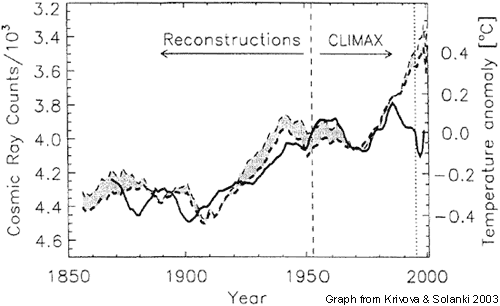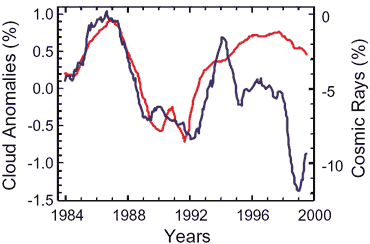
Figure 1: Reconstructed cosmic radiation (solid line before 1952) and directly observed cosmic radiation (solid line after 1952) compared to global temperature (dotted line). All curves have been smoothed by an 11 year running mean (Krivova 2003).
What The Science Says:
While the link between cosmic rays and cloud cover is yet to be confirmed, more importantly, there has been no correlation between cosmic rays and global temperatures over the last 30 years of global warming. In fact, in recent years when cosmic rays should have been having their largest cooling effect on record, temperatures have been at their highest on record.
Climate Myth: It's cosmic rays
"When the Sun is active, its magnetic field is better at shielding us against the cosmic rays coming from outer space, before they reach our planet. By regulating the Earth’s cloud cover, the Sun can turn the temperature up and down. ... As the Sun’s magnetism doubled in strength during the 20th century, this natural mechanism may be responsible for a large part of global warming seen then." (Henrik Svensmark)
Cosmic rays may play a part in helping form clouds. If this is the case, increased cosmic rays would lead to more cloud cover, resulting in a cooling effect. Conversely, decreased cosmic rays would warm the earth. To calculate the maximum possible role of cosmic rays in recent warming, global temperatures were compared to cosmic radiation levels measured by neutron monitors at the Earth's surface. While there was good correlation between cosmic radiation and temperature prior to 1970, the correlation breaks down sharply after 1970. The analysis concludes that "between 1970 and 1985 the cosmic ray flux, although still behaving similarly to the temperature, in fact lags it and cannot be the cause of its rise. Thus changes in the cosmic ray flux cannot be responsible for more than 15% of the temperature increase" (Krivova & Solanki 2003).

Figure 1: Reconstructed cosmic radiation (solid line before 1952) and directly observed cosmic radiation (solid line after 1952) compared to global temperature (dotted line). All curves have been smoothed by an 11 year running mean (Krivova 2003).
Similarly, a comparison of neutron monitor measurements, Beryllium 10 and Carbon 14 isotopes (both proxies for cosmic radiation) with global temperatures found that cosmic rays "have been in the opposite direction to that required to explain the observed rise in global mean temperatures" (Lockwood 2007). Regardless of whether cosmic rays help form clouds, the trend in cosmic radiation is opposite to that required to cause warming.
There are other problems proving the causality link between cosmic rays and cloud formation. One of the key proofs of Svensmark's cosmic ray theory is the high correlation between low cloud cover and cosmic rays. However, the correlation broke down in 1991 (Laut 2003). At that point, cloud cover began to lags cosmic ray trends by over 6 months while cloud formation should occur within several days (Yu 2000). The correlation completely breaks down in 1994.

Figure 2: Low cloud cover (blue line) versus cosmic ray intensity (red line) (Laut 2003).
Svensmark explained the 6 month lag as data uncertainty (Svensmark 2003). He also claims the loss of correlation after 1994 is due to long term calibration drift with the ISCCP satellites (Marsh & Svensmark 2001). The ISCCP disagree.
In fact, from 1957 through 2012, cosmic rays had a slight upward (cooling effect) trend while global surface temperatures warmed rapidly. Around 2009-2010, cosmic rays reached record high levels, which should mean a large cooling effect if the cosmic ray hypothesis is correct. Instead, global temperatures were at their highest on record (Figure 3). The correlation between the two variables (surface temperatures vs. decreasing cosmic rays) from 1957 to 2012 is -0.009.
Figure 3: Annual average GCR counts per minute (blue - note that numbers decrease going up the left vertical axis, because lower GCRs should mean higher temperatures) from the Neutron Monitor Database vs. annual average global surface temperature (red, right vertical axis) from NOAA NCDC, both with second order polynomial fits.
Erlykin et al. (2013) noted (emphasis added),
"Recent measurements of the cosmic ray intensity show that a former decrease with time has been reversed. Thus, even if cosmic rays enhanced cloud production, there would be a small global cooling, not warming."
Another analysis scrutinizes the link between cosmic rays and cloud cover and finds several discrepancies. As cosmic radiation shows greater variation in high latitudes, one would expect larger changes in cloud cover in polar regions. This is not observed. Examining the nuclear reactor accident at Chernobyl, ionization from the radioactivity would be expected to produce an increase in cloud cover. There is no evident increase in cloud cover following the accident (Sloan & Wolfendale 2007).
Even if these difficulties can be resolved and the causality link between cosmic rays and cloud formation is proven, this would mean cosmic rays would have been imposing a cooling influence on climate over the last few decades.
 |
The Skeptical Science website by Skeptical Science is licensed under a Creative Commons Attribution 3.0 Unported License. |